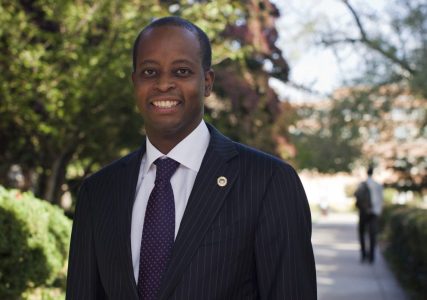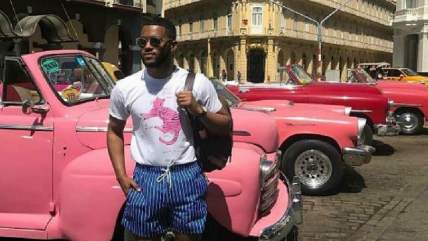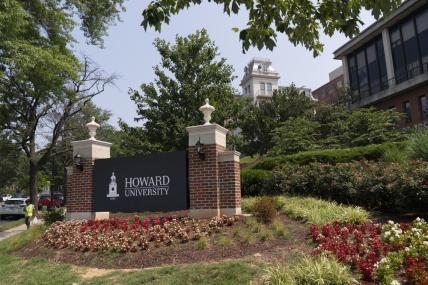Student uprising at Howard University follows storied history of campus protests
Students at the HBCU, through their activism over alleged concerns about mold, rats and roaches, are following precedent of many Howard protests of the past.
“They can cut a check for making sure that there are no rats down in your cafe!” screamed a Howard University student protester to a crowd of hundreds of students on Wednesday afternoon.
The speech was made during a second day of a student-led sit-in at the Washington D.C.-based HBCU for complaints relating to inhumane living conditions, COVID concerns and lack of student representation on the Board of Trustees. Protesters said that their concerns have fallen on deaf ears, so their occupation of two-floors in a student affairs building is to let the administration know they have had enough.
One of the pressing issues is the presence of rats and roaches that students say they see in their dormitories and various eating facilities around the campus. There have also been complaints about mold around the residence halls and classrooms.
According to a letter from the school’s Vice President of Student Affairs Cynthia Evers late Wednesday morning, during the Tuesday night student town hall, protesters “interrupted the constructive dialogue” and “instigated a sit-in in the Blackburn Multipurpose Center.” Evers also claims that students forcibly moved to occupy the building committing “multiple violations” of the Student Code of Conduct, which could lead to expulsion of any protesters who still remain in the building past 12:00 p.m. ET on Wednesday
“Administration was not there,” said one of the student protesters to theGrio, who wants to remain anonymous due to safety and academic concerns. The student states that there are several discrepancies on Evers’ account.
The protester states that the town hall meeting was hosted by Howard University’s Student Association (HUSA) because of the ongoing health and representation concerns that students have vocalized since the start of the semester.
Administration was invited to the meeting, but she said they did not attend it.

Instead, the protester tells theGrio that it was an hour and ten minute Q&A, where the 50 to 60 student attendees shared their grievances with each other, including several transfer students, who said that they have been home insecure because the institution could not accommodate housing for them even though they were promised a space to live in.
The students moved to occupy the building right after the meeting ended just after 7:00 pm, she said.
Evers, however, came to the building just before 9:00 pm, according to the student.
The Vice President of Student Affairs has not responded to theGrio‘s request for comment.
“Honestly, we are passing over a message and a demand that’s going on for years,” said another student protester to theGrio. The protester also exclaimed that issues about the vermin on campus and the lack of transparency with the administration have been going on for years.
In 2012, a group 19 students sued Howard University for a roach and rat infestation in their dorms at the school’s Plaza Towers. The university responded to the issue, stating that they would rev up fumigation efforts.
However, in 2015, students again complained about the rat and mold problem around campus and demanded that Howard does something to fix it. They also requested that the administration fixes financial aid glitches and complained about the increasing tuition rate. During that year, the private university cost nearly $23,000 a year. Today, its tuition is more than $28,000 a year.
“Beyond that, people have been complaining, but it’s just been normalized in so many ways,” the protester added. “There’s a disconnect between admin and student, but it’s just been normalized or something, which is brushed under the rug.”
Among the list of demands, the students are requesting a meeting with university officials, including President Wayne Frederick, by the end of the month to voice their concerns directly to the people in power.
The group of students are a part of the Live Movement, which is a coalition of students at the HBCU that advocate for education reform and academic advancement for Black students, started by Howard senior Aniyah Vines. Vines is one of the main organizers and participants of the sit-in.
The initial group of tens of protesters Tuesday night, has now grown to a hundreds of students, who are both inside and outside the Blackburn building.
The protesters have received widespread support from several campus organizations including the Howard University NAACP, Howard’s Alumni Network, and the student council. Late Tuesday evening, the Howard University Faculty Senate, which is made up of all full-time faculty at the school, sent a letter of support to the students stating that they “voted to stand with, and reach out to, students.”
The students will not leave the university center until the administration agrees to enter talks.
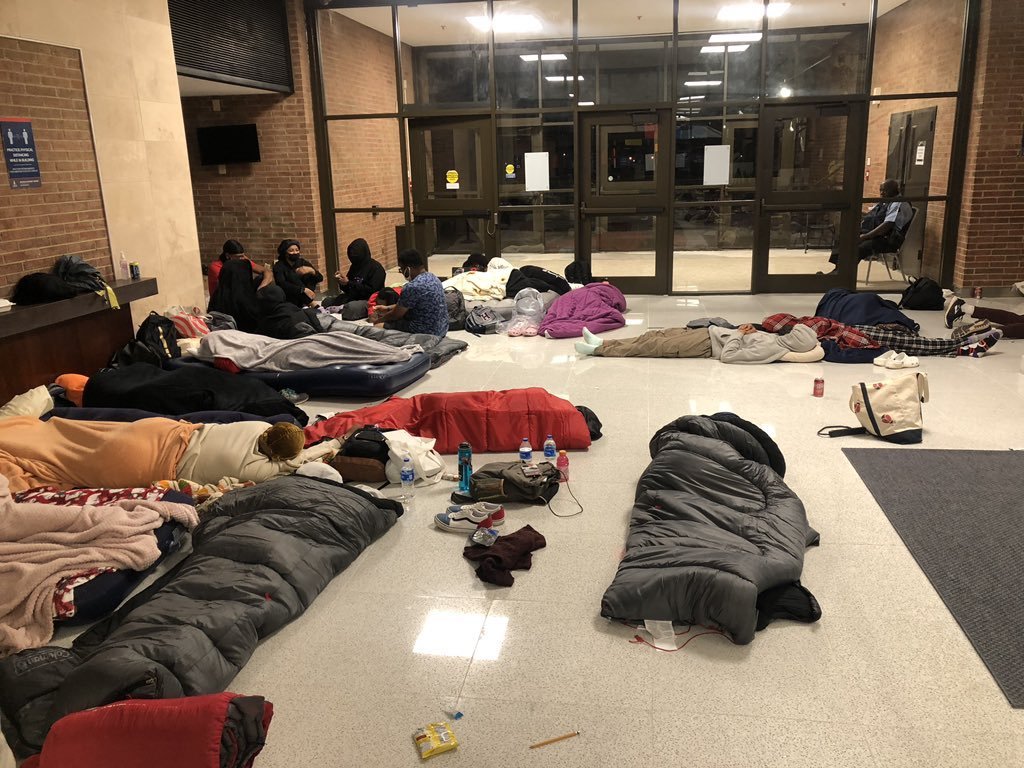
The history of student protests at Howard traces back to the 1960s, when the Civil Rights movement spurred students to request institutional changes at the university founded two years after the Civil War ended.
On March 19, 1963, over 1,000 students seized the Johnson administration building, which is home to the core university staff like the president and the financial aid office.
The students occupied the building for three days, sitting in then President James Nabrit‘s office until the school responded to their demands. They fought for course changes, a streamlined process for disciplining students and the resignation of Nabrit, whom students claim was a negligent leader who did not listen to them.
Prior to the protest, Howard’s curriculum reflected the tone and subject matters of most institutions of that time: a white-washed history that seldom focused on the efforts and toils of Black Americans.
The students wanted the school to not only emphasize Black history and culture, but for the school to drop the charges against the 39 students who protested for the same issues three weeks earlier during Howard’s Charter Day celebration. There was also a request for a judiciary system for student discipline to review the charges against those students and be in place for future uprisings.
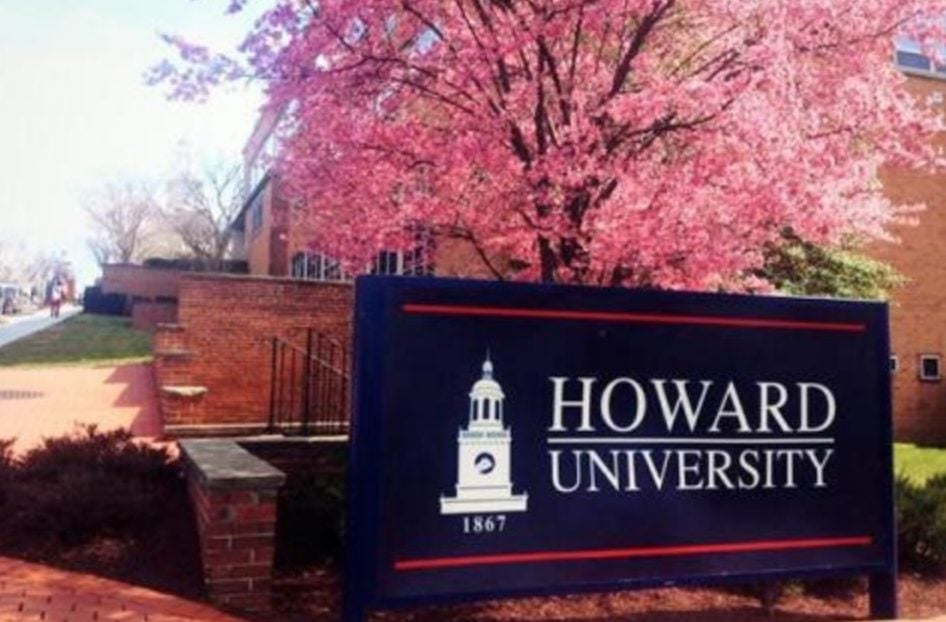
Administration officials conceded on the third day, granting two of the four demands of the students.
“We had no idea it would take on this kind of significance,” said Anthony Gittens, a Howard senior and leader during the 1968 demonstration, told the campus’s student newspaper The Hilltop in 2018. Officials also promised to negotiate with students to resolve their other demands. “We had done a lot of demonstrating for years so this was one more. We had no idea that this would be as significant as it seems to have been.”
The win for students drastically changed the structure of the university and built the basis of the Black-centered curriculum that Howard is known for today. It also set precedent for future protests by students.
One of the most notorious was the 1989 protest against the university’s appointment of Republican strategist Lee Atwater to the school’s Board of Trustees.
Students claimed that Atwater, who was a political consultant for presidents like Ronald Reagan and George H. W. Bush, was not sensitive to Black concerns and should not be in the group that provides leadership and governance the school that is majority-Black students.
In addition, they also requested improvements to student services, like better security, housing and more Black members on the Board of Trustees in general.
Atwater resigned on March 7, 1989, amidst pressure from the students and growing violence between the student protesters and the District of Columbia police, who arrived in riot gear to arrest up to 1,000 students that barricaded themselves in the building for the two days.
This story was documented in Howard alumnus, and Associate Professor of Africana Studies, Joshua Myers’ book, We Are Worth Fighting For: A History of the Howard University Student Protest of 1989.
Just three years ago, hundreds of Howard students made headlines again during a nine-day takeover of the A building in efforts to change some of the school’s policies.
The group of students, organized by Black liberation organization HU Resist, had a list of nine demands for the university to address, including having adequate housing for younger students, the disarming of campus police, a promise to combat food insecurity that affected students and protocols to fight rape culture on campus.
In addition, students called for more transparency of the school’s finances, after the very public scandal broke out about members of the school’s financial aid office misappropriating thousands of dollars worth of student financial aid funds.
One former student employee, Tyrone Hankerson Jr., scammed nearly $450,000 from Howard’s financial aid coffers.
Howard President Wayne A. I Frederick said in a statement during that time that a “criminal prosecution” will ensue to rectify the problem. However, students called for Frederick’s resignation for negligence and complacency in the matters, but later rescinded this demand.
Frederick remains the president today.
The university and students reached an agreement in the end, with Howard meeting most of the demands of students, if not promising to alleviate the issue in the near future.
Some of the solutions included overhauling the school’s sexual assault policy, creating a food bank to serve the students and locals, and reviewing the policies that allowed campus police officers to carry weapons.
“Since the beginning of the semester, there are juniors and seniors who do not have housing,” said the student protester, who says the protesters are just a representation of the many students living in “hell.” While occupying, she said the group has been bullied and threatened by police, Evers and the Shelton Higgins, who students claim is the university’s new director of resident life.
Though students and campus newspaper say Higgins started as director at the beginning of the fall semester, Howard has yet to announce his new role and he is not listed as such on its website. TheGrio reached out to Howard’s office of residence life and university housing but had not been able to reach anyone to clarify.
“The police tore the banner down twice,” said the protester, who claims that after the group made a banner that stated “#Blackburntakeover, Enough is Enough, Howard Admin WYA,” campus police seized the sign on two occasions before crippling it up and throwing it in the garbage.
She also claimed that the police manhandled and bodied several protesters, as they entered and exited the building, causing one of the protesters to get badly scratched and needing a bandage.
“You are not protecting or serving anyone right now,” she said about the presence of police at the scene, that has made all the protesters feel uncomfortable.
A fire alarm was also set off in the building. And although the group did not see who pulled it, she said the alarm was next to a group of officers near one of the exits in the building. The fire department came to the building, but there was no fire she said.
There was also reports that staff turned off the wifi in the building, however, the student states that some of the protesters can get on the wifi while others cannot. There has not been consistent and stable wifi or internet across campus, since the ransomware hack that happened earlier in September.
“Everyone was acting calm and then the VP (Evers) started saying threats,” she continued.
She said that the group was told that their occupancy violated the student code of conduct, that they would be expelled, and then Evers began taking photos of students against their consent.
“We asked her to stop taking photos and videos of us,” she said they insisted, but the vice president continued.
She also claimed that Director Higgins told the students that “it might be mold, but it is not Black mold,” despite several of the protesters claiming they needed health services after being exposed to black mold. A inaudible video circulating on Twitter shows Higgins speaking to the protesters, with the caption, “Howard University staff member tells protesters that the university has found no black mold. Several students have complained of black mold in their dorms.”
Higgins did not respond to theGrio‘s request for comment.
The anonymous protester also stated that Metropolitan Police (MPD) were called on the group during the night as well. Vines adds that MPD even tried to forcefully remove the occupants from the building.
The students aren’t alone, and supported by many local grassroots organizations like Harriets Wild Dreams (HWD), Freedom Fighters DC, Concerned Citizens, and Unfilled Freedom DC, who have provided resources, finances or stood in solidarity with the students.
The four demands the students have requested are:
- Academic amnesty: Since protesters have missed midterms and other important grades, they want to make sure that faculty can make accommodations for them to take assignments at a later date.
- In-person town hall with President Frederick: The students are requesting a public town hall meeting with the president, students and general public before the end of October.
- Affiliate trustee positions: The students are requested that the three affiliate positions on the board of trustees — which include a seat for a student, alumni and faculty — to be reinstated.
- Housing plan: The students are requesting that a concrete plan for how the institution will house displaced students will be provided as soon as possible.
Howard President Frederick has yet to publicly acknowledge the protesters or respond to theGrio‘s request for comment.
Vines said that Frederick invited her and HUSA President, Kylie Burke, for a “student leadership meeting,” early Thursday afternoon, but argued that his effort is not meeting the demand to have a public meeting with me and students and members of community before Oct. 31.
Earlier this year, Frederick who has held his position for seven years, ranked in as the highest-paid university president in the greater D.C. area, receiving an annual salary of $1,070,322.
Have you subscribed to theGrio’s “Dear Culture” podcast? Download our newest episodes now! TheGrio is now on Apple TV, Amazon Fire and Roku. Download theGrio.com today!
